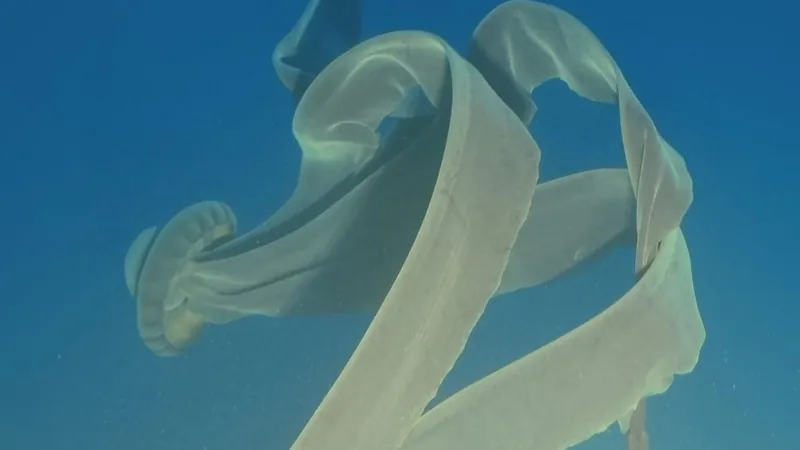
Meet the Giant Phantom Jelly: The 33-Foot Marine Marvel That Gives Birth Through Its Mouth!
2025-01-25
Author: Ting
Introduction
The mysterious colossal dweller of the ocean, known as the Giant Phantom Jelly (Stygiomedusa gigantea), roams every ocean except the Arctic, showcasing nature's brilliance in the darkest depths of our planet. This enigmatic creature has captivated researchers and marine enthusiasts alike due to its astounding size and unique reproductive method.
Physical Characteristics
Weighing its massive dimensions, the Giant Phantom Jelly boasts a bell that expands to about 3.3 feet wide (1 meter) and possesses four ethereal, ribbon-like arms that can extend up to an astonishing 33 feet (10 meters). This makes it one of the largest invertebrate predators inhabiting our oceans.
Historical Encounters
The first recorded specimen of this elusive jelly was collected in 1899, with its distinct characteristics detailed in a scientific description a decade later. Astoundingly, only around 120 encounters with this marine giant have been documented since then, primarily due to its preference for residing in the deep ocean, often plunging down to depths as extreme as 22,000 feet (6,700 meters). These immense depths are characterized by tremendous pressure, yet the Giant Phantom Jelly has adapted remarkably—its compressible, squashable body allows it to thrive under such conditions.
Recent Discoveries
In a breakthrough year for marine exploration, 2022 witnessed researchers successfully spotting the Giant Phantom Jelly on three separate occasions during submersible expeditions in the Antarctic waters. The encounters revealed these jellyfish swimming at shallower levels, between 260 and 920 feet (80 to 280 meters). Researchers suspect that during certain seasonal shifts, the jellies venture closer to the surface as increased sunlight draws their prey, like plankton and small fish, upward.
Feeding Mechanism
Unlike their more familiar jellyfish relatives, the Giant Phantom Jellies lack stinging tentacles. Instead, they deftly ensnare their prey using their long, flexible arms, which allow them to transport their meals directly to their mouths.
Reproduction
What sets the Giant Phantom Jelly apart is its remarkable viviparous reproductive method. Unlike most jellyfish that release fertilized eggs into the ocean, these jellies bear live young. The tiny creatures develop within the mother's body before making a dramatic exit, swimming out through her mouth!
Bioluminescence
Additionally, under specific lighting conditions, these jellies display a soft orange-red glow due to bioluminescence. Scientists are still unraveling the reasons behind this glow, which could serve multiple purposes, including communication, predator confusion, prey attraction, or mate solicitation. However, given that their natural habitat lies in the profound dark ocean, the faintness of their glow likely aids in evading potential threats.
Conclusion
The Giant Phantom Jelly continues to intrigue marine biologists and ocean lovers, reminding us of the many hidden marvels lurking beneath the surface of our oceans. With further exploration and understanding, who knows what other extraordinary secrets these deep-sea giants might unveil?




 Brasil (PT)
Brasil (PT)
 Canada (EN)
Canada (EN)
 Chile (ES)
Chile (ES)
 Česko (CS)
Česko (CS)
 대한민국 (KO)
대한민국 (KO)
 España (ES)
España (ES)
 France (FR)
France (FR)
 Hong Kong (EN)
Hong Kong (EN)
 Italia (IT)
Italia (IT)
 日本 (JA)
日本 (JA)
 Magyarország (HU)
Magyarország (HU)
 Norge (NO)
Norge (NO)
 Polska (PL)
Polska (PL)
 Schweiz (DE)
Schweiz (DE)
 Singapore (EN)
Singapore (EN)
 Sverige (SV)
Sverige (SV)
 Suomi (FI)
Suomi (FI)
 Türkiye (TR)
Türkiye (TR)
 الإمارات العربية المتحدة (AR)
الإمارات العربية المتحدة (AR)